|
I have lots of favorites up there: Longoria,
Qupe, Au Bon Climat, Jaffurs. Recently I had the
opportunity to taste through a number of recent releases by a winery
I’ve long admired but perhaps not given the respect it deserves—Beckmen.
Maybe it’s because its wines are so reasonably priced, or that it makes
a wide range of wines rather than focusing on two or three favored
varieties. Regardless, I thought it was time to revisit and find out if
my past enjoyment of the wines still held. A few days later, I was
introduced to a winery that has long sold grapes, but only recently
started getting attention for its own wines—Huber Cellars. After
tasting, I realized that I would have to add another winery to my
growing list of “favorites” from Santa Barbara.
Beckmen Vineyards
Beckmen Vineyards was founded by Tom Beckmen
in 1994. As a child, Tom had worked on his family’s ranch outside of
Chicago, picking tomatoes and onions, so he had a taste of the life of a
farmer, and a connection to the land. His career didn’t begin in wine or
farming, however. Beckmen’s career began in music. Tom founded the
visionary Roland Corporation, a
pioneer in electronic pianos, keyboards, and other music-related
electronics that merged music with computer applications. Having
achieved success in one venture, Tom sold Roland in 1993 to use his
background in farming to create something equally visionary from the
land. He founded Beckmen Vineyards in 1994.
Convinced of the tremendous potential of the Santa Ynez Valley, Tom
Beckmen undertook an extensive and painstaking search for the ideal
location to establish Beckmen Vineyards. He finally found what he was
looking for on a small and neglected 40-acre parcel with an existing
small winery near Los Olivos. Together, Tom and his winemaker son Steve
removed the 16 original acres of Chardonnay, Sauvignon Blanc, and
Cabernet Sauvignon that had not realized their full potential due to
neglect and incorrect variety selection. The vineyard was replanted to
the correct variety selection on the correct rootstock, implementing
modern viticulture practices in the vineyard.
But this vineyard, as promising as it appeared, didn’t fully give voice
to the vision the Beckman’s had to create something unique in
Santa Barbara County. In particular, they believed that the region had
the ideal climate and growing conditions for producing stunning Rhone
varietals, like Syrah and Grenache. Bob
Lindquist’s Qupe had proven that great Syrah could be
produced in the region, but few had followed his example. After yet
another careful search, the Beckmen’s purchased the property that would
become Purisima Mountain Vineyard,
an unplanted 365-acre Santa Ynez Valley ranch uniquely suited to Rhone varietals. Located at 1250’ elevation above Ballard Canyon, farming of Purisima Mountain Vineyard represents one of the most ambitious hillside
vineyard endeavors in the Santa Ynez Valley. The high elevation, unique
microclimate and rare limestone sub-soil make this vineyard one of the
most special winegrowing sites in all of Santa Barbara County.
Purisima Mountain Vineyard is planted mostly to Rhone varietals, such as
Syrah, Grenache, Mourvedre, etc., but Beckmen also planted Sauvignon
Blanc and Cabernet Sauvignon to supplement their original Santa Ynez
vineyard. To fully develop their vineyard’s potential, the Beckmen’s
instituted sustainable farming practices from the beginning, and later
introduced the somewhat controversial practices of biodynamic farming.
Fully biodynamic since 2006, the use of these practices has, in
Beckmen’s opinion, made significant improvements in the quality of the
fruit and the resulting wines.
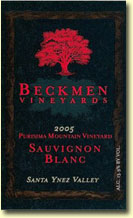 2006
Beckmen Sauvignon Blanc, $12.99. Classic SB nose of grapefruit, cut
grass, and a hint of melon. Very crisp and clean, with significant
minerality supporting lemon/grapefruit, aromatic herbs that are savory
but not vegetal, and a fairly long, clean finish. This is closer to the
crisp New Zealand style of Sauvignon, as opposed to the richer,
melon/fig style of, say, Ojai or Rochioli. Great food Sauvignon. Find this wine 2006
Beckmen Sauvignon Blanc, $12.99. Classic SB nose of grapefruit, cut
grass, and a hint of melon. Very crisp and clean, with significant
minerality supporting lemon/grapefruit, aromatic herbs that are savory
but not vegetal, and a fairly long, clean finish. This is closer to the
crisp New Zealand style of Sauvignon, as opposed to the richer,
melon/fig style of, say, Ojai or Rochioli. Great food Sauvignon. Find this wine
2005 Beckman Le Bec Blanc, $19.99. The white version of the Cuveé
Le Bec, but 100% of the fruit comes from Purisima Mountain Vineyard.
59% Roussanne, 32% Marsanne, 9% Grenache Blanc, about 40% of the wine goes
through malolactic. Golden color, spicy/sweetish nose of tropical
fruits/peaches/apricots. Rather soft structure, creamy and fairly rich,
nice mélange of the flavors typical of white Rhone blends: pit fruit,
allspice, citrus. Soft finish turns a bit flat. A nice wine, although I
would have liked a bit more acid to balance and lift the rich fruit. I
often have a hard time pairing domestic Rhone whites with foods, and
this wine strikes me as more of a sipper than a food wine. Find this wine
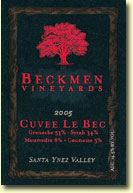 2005 Beckmen Cuveé Le Bec, Santa Ynez Valley, $15.99. Beckmen’s
Cuveé Le Bec has long been one of my favorite “value” Rhone-style
blends, and the current vintage does not disappoint. Using four of the
classified grapes of Chateauneuf du Pape grown at their Purisima
Mountain Vineyard, the blend this year consists of 53% Grenache, 34%
Syrah, 8% Mourvedre, and 5% Counoise. Ripe but not over-done and
extremely well balanced, the wine is spicy with terrific fruit, smooth
tannins, and real complexity. No one variety stands out, but I can
taste a bit of the blueberry/bacon fat of the Syrah, the spicy/cherry
qualities of the Grenache, and the meatiness of the Mourvedre. Damn
tasty stuff here. 2005 Beckmen Cuveé Le Bec, Santa Ynez Valley, $15.99. Beckmen’s
Cuveé Le Bec has long been one of my favorite “value” Rhone-style
blends, and the current vintage does not disappoint. Using four of the
classified grapes of Chateauneuf du Pape grown at their Purisima
Mountain Vineyard, the blend this year consists of 53% Grenache, 34%
Syrah, 8% Mourvedre, and 5% Counoise. Ripe but not over-done and
extremely well balanced, the wine is spicy with terrific fruit, smooth
tannins, and real complexity. No one variety stands out, but I can
taste a bit of the blueberry/bacon fat of the Syrah, the spicy/cherry
qualities of the Grenache, and the meatiness of the Mourvedre. Damn
tasty stuff here.
Find this wine
2005 Beckmen Grenache Estate, Santa Ynez Valley, $20.99.
Beckmen’s estate Grenache (as opposed to their higher-end Purisima
Mountain-designated Grenache) is designed to be an inviting,
fruit-forward wine that can be enjoyed in its youth for its exuberance
and delicious fruit. This wine has all the spicy qualities that Grenache
is know for: flavors of strawberry, raspberry and pomegranate dominate,
with just a touch of bacon fat to remind you of its Rhone-ish roots.
With good balance of tannins and acid, this wine would be extremely
versatile with grilled meats or other savory dishes. This avoids the
candied character of some domestic Grenache. Find this wine
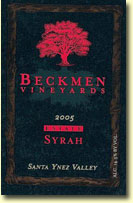 2005
Beckmen Syrah Estate, Santa Ynez Valley, $18.99. This Syrah is made
from 30 individual lots consisting of 7 different clones of Syrah from
both their Los Olivos vineyard and the Purisima Mountain Vineyard. The
nose is characteristic of a warmer-climate syrah, with spice and meaty
scents. On the palate it has the classic qualities of Syrah, with rich
meaty flavors accented with black pepper, licorice, clove and cedar that
are rich and satisfying, supported by a touch (1/3) of new oak. Very
good Syrah for the money, although it lacks either the richness or
complexity of the best Santa Barbara County Syrahs (most of which cost
considerably more). Find this wine 2005
Beckmen Syrah Estate, Santa Ynez Valley, $18.99. This Syrah is made
from 30 individual lots consisting of 7 different clones of Syrah from
both their Los Olivos vineyard and the Purisima Mountain Vineyard. The
nose is characteristic of a warmer-climate syrah, with spice and meaty
scents. On the palate it has the classic qualities of Syrah, with rich
meaty flavors accented with black pepper, licorice, clove and cedar that
are rich and satisfying, supported by a touch (1/3) of new oak. Very
good Syrah for the money, although it lacks either the richness or
complexity of the best Santa Barbara County Syrahs (most of which cost
considerably more). Find this wine
2005 Beckmen Cabernet Sauvignon Estate, Santa Ynez Valley, $21.99.
Although a Rhone-varietal specialist, Beckmen has always made wines
from Cabernet, too. Notwithstanding the reputation of Santa Barbara
County for producing thin, weedy cabs, Beckmen manages to make something
interesting here. The long growing season in 2005 (the grapes weren’t
harvested until November!) apparently allowed the grapes to fully ripen
yet retain their balancing acidity. This wine is fairly rich, and,
thankfully, tastes of varietally-correct Cabernet fruit that avoids the
herbaceousness that used to be the norm in cabs from this area. Nice plummy fruit, the touch of savory herbs and medium body could be
characterized as representing a St. Emilion style (although this wine
has no Merlot, which dominates most St. Emilion’s), as opposed to Napa’s
Medoc. Not especially complex or deep, but well balanced with moderate
tannins and a decent finish. Very nice if not earthshaking cab at a fair
price. Find this wine
Huber Cellars
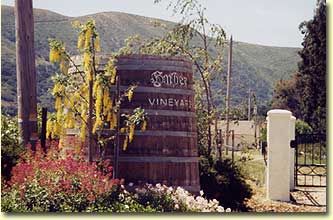 I first became aware of Huber as the name of a vineyard that began
appearing on the wines of other producers in Santa Barbara County in the
late 1990’s. I particularly remember fondly a fabulous
1999 Longoria “Huber Vineyard” Chardonnay
that had amazing minerality and laser-like acidity, a wine that
blossomed and developed tremendous complexity over several years of
drinking in the early 2000’s. I had no idea that the
Huber Vineyard was also a
winery, until I happened to notice a sign on Highway 246, as I drove up
to attend the Clos Pepe Allocation BBQ last year. Since Longoria no
longer makes a Chardonnay from Huber, I was determined to explore
further in the hopes of finding another Chardonnay that had the zing I
so enjoyed in that 1999 Longoria. I first became aware of Huber as the name of a vineyard that began
appearing on the wines of other producers in Santa Barbara County in the
late 1990’s. I particularly remember fondly a fabulous
1999 Longoria “Huber Vineyard” Chardonnay
that had amazing minerality and laser-like acidity, a wine that
blossomed and developed tremendous complexity over several years of
drinking in the early 2000’s. I had no idea that the
Huber Vineyard was also a
winery, until I happened to notice a sign on Highway 246, as I drove up
to attend the Clos Pepe Allocation BBQ last year. Since Longoria no
longer makes a Chardonnay from Huber, I was determined to explore
further in the hopes of finding another Chardonnay that had the zing I
so enjoyed in that 1999 Longoria.
I learned that Huber Cellars is a true “Mom ‘n Pop” operation in the
best sense of the term. Norman and Traudl Huber,
a couple in their 70’s, originally hail from Germany. Norman’s vocation
had been as a woodworker, and such is his skill that he headed up the
restoration project for the staterooms and restaurants on the Queen
Mary, now permanently docked in my current home town of Long Beach. They
established this small, family-run estate in 1986, and planted vines in
what is now known at the Sta. Rita Hills in 1987, directly across the
road from Babcock, Melville, and Clos Pepe Estate.
For years they sold their outstanding grapes to such prestigious estates
as Longoria, Gainey, and Brewer-Clifton, but
beginning in 2000 they began using a portion of their grapes to make
wine under their own Huber Cellars label.
Today their vineyard is managed by the Brewer-Clifton team, and their
wine is made by well-respected winemaker Norm
Yost (Flying Goat Cellars). The Huber’s continue to sell some
of their Chardonnay grapes to Greg Brewer
for his Brewer-Clifton and Diatom labels. As for the Huber Cellars
wines, they still pretty much fly under the radar compared to their
neighbors in the Sta. Rita Hills. So low-key is this operation, that
Norman and Traudl still personally hand-deliver their wine to the store
I work at here in Long Beach! Talk about personal service. There’s loads
of personality in their wines, too. They make four wines from three
different grape varieties—Chardonnay, Pinot Noir, and, perhaps most
interesting of all, a rare German red grape variety known as Dornfelder.
Recently I had the opportunity to taste through the lineup.
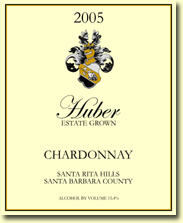 2005 Huber Cellars Chardonnay (No Oak) $21.99 2005 Huber Cellars Chardonnay (No Oak) $21.99
2005 Huber Cellars Chardonnay (French Oak) $26.99
Here we have something that is unusual if not unique. Two Chardonnays
made from the same grapes, from the same vineyard, in the same vintage,
but vinified two different ways. One is made entirely in stainless steel
with no malolactic fermentation (ML). The other is aged in French oak
barrels (20% new), and undergoes partial ML. Both wines are excellent,
and the differences between them are fascinating. The “No Oak” chard is
steely, crisp, with pure apple and pear-infused fruit that is given
tremendous energy by the excellent balance of acidity and richness. The
French Oak version takes that same wine and adds a delicious overlay of
grilled bread, a touch of vanilla, and a creaminess that is luscious
without becoming overbearing. The oak treatment is understated here, but
adds spice without overwhelming the pure Chardonnay flavors, and the
great acidity lifts the wine beautifully. This is very similar to that
great 1999 Longoria I remember so fondly. Tasting these two wines
together is an interesting case study on the effect of oak-aging, but
each wine is excellent in its own right.
Find this wine
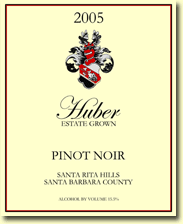 2005 Huber Cellars Pinot Noir, $37.99. This is classic
cool-climate, Sta. Rita Hills Pinot Noir. Clear ruby/cherry color,
bright rich-tasting fruit with cherry, blueberry, a hint of herbs and
forest-floor, ripe plums and rhubarb. Quite long, with perfect acid
balance and moderate tannins. The 2005 vintage provided perfect
conditions for maturing Pinot Noir, and although this wine is big and
ripe (over 15% alcohol) it is not hot, overripe or raisiny. Something
about this area of the Sta. Rita Hills clearly allows for ripe wines to
retain their acidity, the lack of which is too-often the downfall of
other ripe-style pinots. Not a style for Burgundy lovers, but not at all
in the ripe Zinot Noir style, either. Find this wine 2005 Huber Cellars Pinot Noir, $37.99. This is classic
cool-climate, Sta. Rita Hills Pinot Noir. Clear ruby/cherry color,
bright rich-tasting fruit with cherry, blueberry, a hint of herbs and
forest-floor, ripe plums and rhubarb. Quite long, with perfect acid
balance and moderate tannins. The 2005 vintage provided perfect
conditions for maturing Pinot Noir, and although this wine is big and
ripe (over 15% alcohol) it is not hot, overripe or raisiny. Something
about this area of the Sta. Rita Hills clearly allows for ripe wines to
retain their acidity, the lack of which is too-often the downfall of
other ripe-style pinots. Not a style for Burgundy lovers, but not at all
in the ripe Zinot Noir style, either. Find this wine
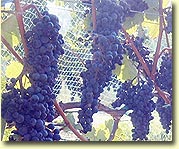 2005 Huber Cellars Dornfelder, Sta. Rita Hills $26.99. OK, now
for something completely different. Dornfelder is a rare German grape
variety
that was originally planted to provide color and depth to light-bodied
German Pinot Noir. The Huber’s were given just 4 Dornfelder vines by a
German friend, who felt they needed a reminder of home in their
vineyard. Since then, they have propagated three acres of Dornfelder
from those original 4 vines, and this amazing wine is the result. The
color has to be seen to be believed—a vivid, glass-staining, day-glow
purple/black. It almost shouldn’t be called a “red” wine, and has got to
be the most intensely pigmented wine I’ve ever seen. You would think
this is going to be an overly-tannic, inky monster, but it’s not.
There’s no question that the wine is full-bodied and rich, yet it has a
wonderful balance and fragrance that is anything but heavy-handed or
oafish. Deep ripe plums, black currants, clove, and chocolate are
combined with bright acids and elegant tannins. Really quite tasty, the
wine is hard to compare with any other varietal in aroma and flavor, but
probably closest to a Syrah/Grenache blend. I’m going to serve this at a
blind tasting someday just to see the reaction. Find this wine 2005 Huber Cellars Dornfelder, Sta. Rita Hills $26.99. OK, now
for something completely different. Dornfelder is a rare German grape
variety
that was originally planted to provide color and depth to light-bodied
German Pinot Noir. The Huber’s were given just 4 Dornfelder vines by a
German friend, who felt they needed a reminder of home in their
vineyard. Since then, they have propagated three acres of Dornfelder
from those original 4 vines, and this amazing wine is the result. The
color has to be seen to be believed—a vivid, glass-staining, day-glow
purple/black. It almost shouldn’t be called a “red” wine, and has got to
be the most intensely pigmented wine I’ve ever seen. You would think
this is going to be an overly-tannic, inky monster, but it’s not.
There’s no question that the wine is full-bodied and rich, yet it has a
wonderful balance and fragrance that is anything but heavy-handed or
oafish. Deep ripe plums, black currants, clove, and chocolate are
combined with bright acids and elegant tannins. Really quite tasty, the
wine is hard to compare with any other varietal in aroma and flavor, but
probably closest to a Syrah/Grenache blend. I’m going to serve this at a
blind tasting someday just to see the reaction. Find this wine
Bennett Traub
Reporting From The Left Coast
Send Bennett an

|


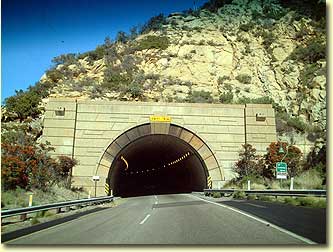 There
are plenty of reasons to enjoy life here in Southern California,
and as a transplanted Midwesterner (South Bend, Indiana), I appreciate
them all. As a wine lover, one of the best is the ability to travel a
relatively short distance to find great wines being made virtually in
our own backyard. Remember the scene in
“Sideways” when Miles and Jack are driving up Highway 101 on
their way to Santa Barbara wine country? There’s that moment when they
drive through the tunnel in the mountains that separates the coast from
the inland valley beyond, and suddenly, there it is—wine country. For
me, that moment is the single most evocative and magical moment in the
whole movie. Because for the last 25 years I have been making the same
trip that Miles and Jack took—to visit the wineries, talk to the
winemakers, drink the wine, experience the magic. And every time I do
so, that moment when I drive through the tunnel is both enchanting and
transformative, a clear demarcation between my regular life and the life
of the vine and wine beyond. (tunnel photo courtesy of
There
are plenty of reasons to enjoy life here in Southern California,
and as a transplanted Midwesterner (South Bend, Indiana), I appreciate
them all. As a wine lover, one of the best is the ability to travel a
relatively short distance to find great wines being made virtually in
our own backyard. Remember the scene in
“Sideways” when Miles and Jack are driving up Highway 101 on
their way to Santa Barbara wine country? There’s that moment when they
drive through the tunnel in the mountains that separates the coast from
the inland valley beyond, and suddenly, there it is—wine country. For
me, that moment is the single most evocative and magical moment in the
whole movie. Because for the last 25 years I have been making the same
trip that Miles and Jack took—to visit the wineries, talk to the
winemakers, drink the wine, experience the magic. And every time I do
so, that moment when I drive through the tunnel is both enchanting and
transformative, a clear demarcation between my regular life and the life
of the vine and wine beyond. (tunnel photo courtesy of
 2006
Beckmen Sauvignon Blanc, $12.99. Classic SB nose of grapefruit, cut
grass, and a hint of melon. Very crisp and clean, with significant
minerality supporting lemon/grapefruit, aromatic herbs that are savory
but not vegetal, and a fairly long, clean finish. This is closer to the
crisp New Zealand style of Sauvignon, as opposed to the richer,
melon/fig style of, say, Ojai or Rochioli. Great food Sauvignon.
2006
Beckmen Sauvignon Blanc, $12.99. Classic SB nose of grapefruit, cut
grass, and a hint of melon. Very crisp and clean, with significant
minerality supporting lemon/grapefruit, aromatic herbs that are savory
but not vegetal, and a fairly long, clean finish. This is closer to the
crisp New Zealand style of Sauvignon, as opposed to the richer,
melon/fig style of, say, Ojai or Rochioli. Great food Sauvignon.  2005 Beckmen Cuveé Le Bec, Santa Ynez Valley, $15.99. Beckmen’s
Cuveé Le Bec has long been one of my favorite “value” Rhone-style
blends, and the current vintage does not disappoint. Using four of the
classified grapes of Chateauneuf du Pape grown at their Purisima
Mountain Vineyard, the blend this year consists of 53% Grenache, 34%
Syrah, 8% Mourvedre, and 5% Counoise. Ripe but not over-done and
extremely well balanced, the wine is spicy with terrific fruit, smooth
tannins, and real complexity. No one variety stands out, but I can
taste a bit of the blueberry/bacon fat of the Syrah, the spicy/cherry
qualities of the Grenache, and the meatiness of the Mourvedre. Damn
tasty stuff here.
2005 Beckmen Cuveé Le Bec, Santa Ynez Valley, $15.99. Beckmen’s
Cuveé Le Bec has long been one of my favorite “value” Rhone-style
blends, and the current vintage does not disappoint. Using four of the
classified grapes of Chateauneuf du Pape grown at their Purisima
Mountain Vineyard, the blend this year consists of 53% Grenache, 34%
Syrah, 8% Mourvedre, and 5% Counoise. Ripe but not over-done and
extremely well balanced, the wine is spicy with terrific fruit, smooth
tannins, and real complexity. No one variety stands out, but I can
taste a bit of the blueberry/bacon fat of the Syrah, the spicy/cherry
qualities of the Grenache, and the meatiness of the Mourvedre. Damn
tasty stuff here.  2005
Beckmen Syrah Estate, Santa Ynez Valley, $18.99. This Syrah is made
from 30 individual lots consisting of 7 different clones of Syrah from
both their Los Olivos vineyard and the Purisima Mountain Vineyard. The
nose is characteristic of a warmer-climate syrah, with spice and meaty
scents. On the palate it has the classic qualities of Syrah, with rich
meaty flavors accented with black pepper, licorice, clove and cedar that
are rich and satisfying, supported by a touch (1/3) of new oak. Very
good Syrah for the money, although it lacks either the richness or
complexity of the best Santa Barbara County Syrahs (most of which cost
considerably more).
2005
Beckmen Syrah Estate, Santa Ynez Valley, $18.99. This Syrah is made
from 30 individual lots consisting of 7 different clones of Syrah from
both their Los Olivos vineyard and the Purisima Mountain Vineyard. The
nose is characteristic of a warmer-climate syrah, with spice and meaty
scents. On the palate it has the classic qualities of Syrah, with rich
meaty flavors accented with black pepper, licorice, clove and cedar that
are rich and satisfying, supported by a touch (1/3) of new oak. Very
good Syrah for the money, although it lacks either the richness or
complexity of the best Santa Barbara County Syrahs (most of which cost
considerably more).  I first became aware of Huber as the name of a vineyard that began
appearing on the wines of other producers in Santa Barbara County in the
late 1990’s. I particularly remember fondly a fabulous
1999 Longoria “Huber Vineyard” Chardonnay
that had amazing minerality and laser-like acidity, a wine that
blossomed and developed tremendous complexity over several years of
drinking in the early 2000’s. I had no idea that the
I first became aware of Huber as the name of a vineyard that began
appearing on the wines of other producers in Santa Barbara County in the
late 1990’s. I particularly remember fondly a fabulous
1999 Longoria “Huber Vineyard” Chardonnay
that had amazing minerality and laser-like acidity, a wine that
blossomed and developed tremendous complexity over several years of
drinking in the early 2000’s. I had no idea that the
 2005 Huber Cellars Chardonnay (No Oak) $21.99
2005 Huber Cellars Chardonnay (No Oak) $21.99 2005 Huber Cellars Pinot Noir, $37.99. This is classic
cool-climate, Sta. Rita Hills Pinot Noir. Clear ruby/cherry color,
bright rich-tasting fruit with cherry, blueberry, a hint of herbs and
forest-floor, ripe plums and rhubarb. Quite long, with perfect acid
balance and moderate tannins. The 2005 vintage provided perfect
conditions for maturing Pinot Noir, and although this wine is big and
ripe (over 15% alcohol) it is not hot, overripe or raisiny. Something
about this area of the Sta. Rita Hills clearly allows for ripe wines to
retain their acidity, the lack of which is too-often the downfall of
other ripe-style pinots. Not a style for Burgundy lovers, but not at all
in the ripe Zinot Noir style, either.
2005 Huber Cellars Pinot Noir, $37.99. This is classic
cool-climate, Sta. Rita Hills Pinot Noir. Clear ruby/cherry color,
bright rich-tasting fruit with cherry, blueberry, a hint of herbs and
forest-floor, ripe plums and rhubarb. Quite long, with perfect acid
balance and moderate tannins. The 2005 vintage provided perfect
conditions for maturing Pinot Noir, and although this wine is big and
ripe (over 15% alcohol) it is not hot, overripe or raisiny. Something
about this area of the Sta. Rita Hills clearly allows for ripe wines to
retain their acidity, the lack of which is too-often the downfall of
other ripe-style pinots. Not a style for Burgundy lovers, but not at all
in the ripe Zinot Noir style, either.  2005 Huber Cellars Dornfelder, Sta. Rita Hills $26.99. OK, now
for something completely different. Dornfelder is a rare German grape
variety
that was originally planted to provide color and depth to light-bodied
German Pinot Noir. The Huber’s were given just 4 Dornfelder vines by a
German friend, who felt they needed a reminder of home in their
vineyard. Since then, they have propagated three acres of Dornfelder
from those original 4 vines, and this amazing wine is the result. The
color has to be seen to be believed—a vivid, glass-staining, day-glow
purple/black. It almost shouldn’t be called a “red” wine, and has got to
be the most intensely pigmented wine I’ve ever seen. You would think
this is going to be an overly-tannic, inky monster, but it’s not.
There’s no question that the wine is full-bodied and rich, yet it has a
wonderful balance and fragrance that is anything but heavy-handed or
oafish. Deep ripe plums, black currants, clove, and chocolate are
combined with bright acids and elegant tannins. Really quite tasty, the
wine is hard to compare with any other varietal in aroma and flavor, but
probably closest to a Syrah/Grenache blend. I’m going to serve this at a
blind tasting someday just to see the reaction.
2005 Huber Cellars Dornfelder, Sta. Rita Hills $26.99. OK, now
for something completely different. Dornfelder is a rare German grape
variety
that was originally planted to provide color and depth to light-bodied
German Pinot Noir. The Huber’s were given just 4 Dornfelder vines by a
German friend, who felt they needed a reminder of home in their
vineyard. Since then, they have propagated three acres of Dornfelder
from those original 4 vines, and this amazing wine is the result. The
color has to be seen to be believed—a vivid, glass-staining, day-glow
purple/black. It almost shouldn’t be called a “red” wine, and has got to
be the most intensely pigmented wine I’ve ever seen. You would think
this is going to be an overly-tannic, inky monster, but it’s not.
There’s no question that the wine is full-bodied and rich, yet it has a
wonderful balance and fragrance that is anything but heavy-handed or
oafish. Deep ripe plums, black currants, clove, and chocolate are
combined with bright acids and elegant tannins. Really quite tasty, the
wine is hard to compare with any other varietal in aroma and flavor, but
probably closest to a Syrah/Grenache blend. I’m going to serve this at a
blind tasting someday just to see the reaction.